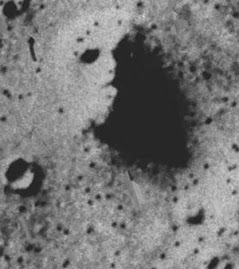skip to main |
skip to sidebar
Life on Mars

There’s a persistent tendency in humans to try to make sense out of everything they see. When Perceval Lowell turned his telescope on Mars, he saw canals. Saw them, mapped them, wrote about them. Others saw them too. The question is, would he ever have seen them at all if he hadn’t already read Schiaparelli’s claim to have observed canali – which translates as “channels” rather than “canals” – crisscrossing the red planet’s surface?
The Rorschach blot test demonstrates our ability to construct a meaning – a story even – out of random shapes and lines. How many of us have seen a figure waving at us beside a road at night, only to have it transform into a fencepost as we pass? Or else some long-lost loved one, turning a busy street-corner in front of us?
The so-called pyramid and face on Mars are surely little more than this. Coincidental shade effects recorded on a sole exposure, copied, talked about, enhanced until they’ve taken on the accoutrements of fact?
And yet. Is that all they are? Can there really have been life on Mars in some far distant epoch? Is there life there now? And, if life, has there ever been intelligence, civilisation, history? I guess the more relevant question is what we hope to achieve by asking?
The only hopeful thing about us, it sometimes seems, is our curiosity. We fondly imagine that the more that we find out, the happier we will become – the wiser, rather. This time we won’t go wrong because we’ve finally seen something amazing enough to matter. …
Submitted for your approval:
• In December 1984 the meteorite ALH84001 was found in Allan Hills, Antarctica. At c. 4.5 billion years old, this is one of the oldest pieces of the solar system still in existence, and it is thought to have originated on Mars. On closer examination, it revealed structures which may be the fossils of microscopic organisms, nanobacteria. At any rate, no completely convincing non-biological explanation has yet been submitted for these traces. Nor have experts ruled out the possibility that, in a far-distant past, such meteorites were instrumental in transferring life from a wet, fecund Mars to Earth.
• In March 2004, NASA announced that its remote-controlled robotic rover Opportunity had discovered evidence that Mars was, in the past, a wet planet. This evidence is mainly in the form of sedimentary bedrock deposits and erosion features difficult to account for under any other hypothesis.
• In December 2006, NASA presented images from its Mars Global Surveyor satellite which suggest that water still occasionally flows on the surface of Mars. While there were no actual pictures of flowing water, changes over time in the appearance of craters and dark spots in the landscape do strongly suggest that something has been flowing there. Dust, possibly, but then again, maybe the Red Planet's lifeblood, liquid water.





No comments:
Post a Comment